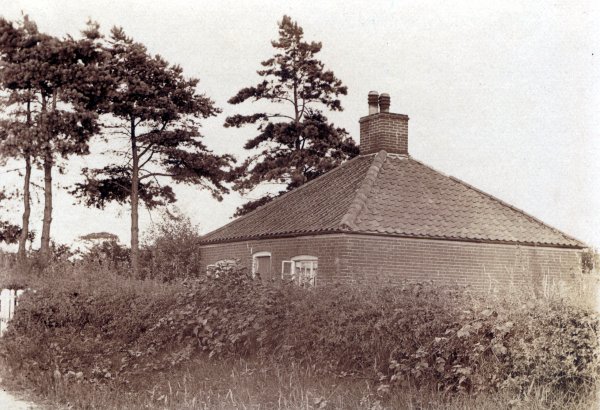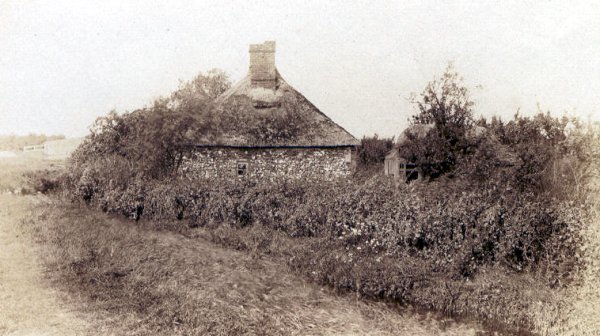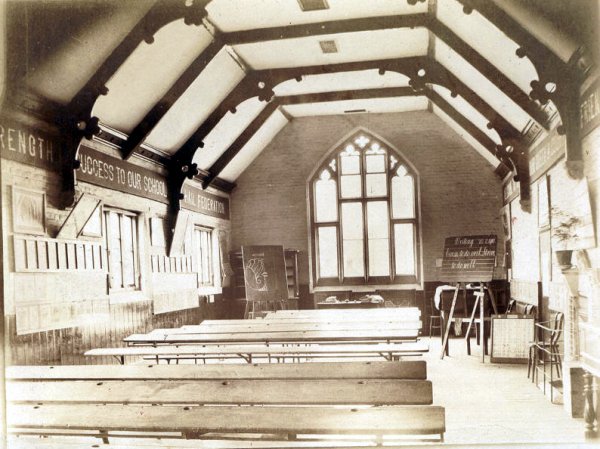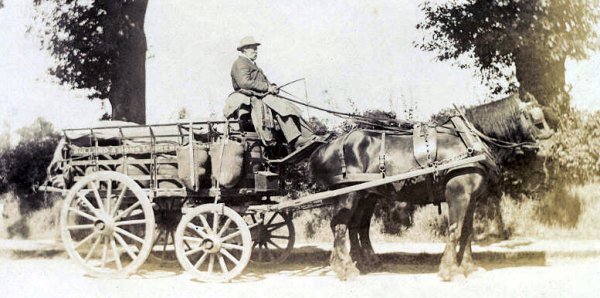

Evelyn Whitethread
My Mother (Annie Elizabeth Rice) was born in one of a pair of cottages facing the approach lane to How Hill -in those days I believe a fruit farm, She was the middle of 5 daughters.and her Mother died when she was 4 years of age. Her Father was a fisherman and he brought up the girls, with the help of the eldest until my Mother was 13. He was good to his girls, and they lived off the produce of his small piece of land and the chickens which he kept, plus no doubt some fish.
She told a most interesting story to us when I was a child, that one of his really good layers "went missing" .He could not find her anywhere, but after three weeks he saw her returning across the meadow, followed by a lot of healthy chicks! and weren't they delighted!
After her Father's death, there was nothing Mother could do but to come up to London to her Aunt. She knew this Aunt well, as she visited another Aunt at Neatishead (near Wroxham) and Mother spent a few days there with her when a child, especially when her cousins came down there for their Summer holidays.
Mother mainly had "living in" jobs as cook and nurse-maid to the Mistress's baby, and loved her work, returning to her Aunt for " time-off" .Here of course, she met up again with her Cousins, one of whom she was truly in love with. So she became Mrs.Annie Jolliffe, and I am one of their children.
To return to Ludham. My Aunt Pamela (next to eldest of the family) married a farm-labourer Bob Watson, (a widower), who had already a family of children, but they had 3 more of their own. We often stayed with Aunt Pamela at The Malthouse then at one of the cottages which backed on to the Ludham Church graveyard, and I often looked out to see the owl at night which was hooting, as Aunt said he would be perched on the Church. (Without success). Lastly she lived in one of the Council houses, where I believe she died.
There was a tiny Baptist Church near the graveyard house, seating about 10 People, so we filled it up. Later I spent my holidays or weekends when I was working at "M.M" mainly with the eldest cousin (Now Annie Slaughter) at 36, Whitegates, or with Cousin Leslie Watson. He had a farm and after retirement a lovely bungalow and large plot of land at"Tanga", Fritton Road. which no doubt is still occupied.
It is sad that after so many years, I have no Cousins to visit there. But I do wonder if you know Cyril Thrower who owned the large Village stores or his Manager (I believe his name was Billy Sloper, who was a resident in a house with a beautiful garden near the village centre). If so, please remember me to
them. I believe they both attend the Methodist Chapel, which we attended after the little Baptist Chapel became a Boot and Shoe Repairer (Probably now demolished).
I loved the Broads, and one of my cousins, Bob Watson, would always take me for a row on the River. Incidentally, my Mother's Uncle Bob Rice owned the Mill which stood by Ludham Bridge. I wonder if it is still there?
Some photographs from Evelyn Whitethread
Mother's birthplace, Rice Family home 1878
Granny Rice's cottage, Ludham Bridge
Ludham Schoolroom
Bullard and Sons Brewery Dray, Yarmouth Road Ludham
More Memories of Evelyn Whitethread
Written in 1993 and sent to Beulah Gowing.
The history of my family started with the Allcocks who lived at Neatishead. Three of the girls I heard about - one married and became Mrs Charles Jolliffe, one married and became Mrs Rice (Ben) and the other lived in the parental home in Neatishead.
Mr and Mrs Charles Jolliffe had three children - William, Annie and Christopher, and they lived in the Fulham area of London. The Rices moved into the cottage at the bottom of the lane leading to How Hill and had 5 girls only - Edith, Pamela, Annie, Merab and Sarah. Mrs Rice died when Sarah was born and Annie was 4 years old.
The Allcock girl, a few years later, had her two cousins to stay with her for the holidays and this is the first time William Jolliffe and Annie Rice had met and they were very fond of each other. When she was 13 years old, Annie’s father died, so she got a living-in job as a cook and nursery maid to a family in London, under the watchful eye of Mrs Chas. Jolliffe, where Annie spent her free time. So the two cousins came into frequent touch and eventually, William and Annie married, and I became one of their off-spring (with 3 brothers, Frank, Stanley and Charles-Benjamin). This is my background and I am Evelyn Whitethread (née Jolliffe).
For many years, the Jolliffe family came down to Ludham from Thornton Heath and stayed with Uncle Bob Watson and Auntie Pamela and had a lovely time with our cousins - Annie, Leslie, Bob and “Little Evie” (another Evelyn). Many people in Ludham may remember these cousins although as Bob went to America when he was 17, he might not be known. He is still living there but is a very sick man. When he was a lad he was a terrible tease and never so happy as when trying to put a frog down the back of my neck!
Annie married Billie Slaughter who worked on the fruit farm at How Hill for Mr Boardman. They lived in Whitegates. Leslie had a farm, and on retirement, lived at “Tanga”. He married Millie, and Evie married Leslie Barker and they lived in Norwich. She was a cook to the two Miss Colmans. Leslie’s offspring are still alive, also Evie’s.
The journey to Ludham was of great interest to us - train from Thornton Heath to London Bridge, then bus to Liverpool Street and train from there to Norwich (where I believe we changed). This was Norwich Thorpe station. Then we took the train to Potter Heigham, all sooty from the steam engines and then a “hike” with numerous bags, cases and a Gladstone bag to Auntie’s. This was either to the Malthouse, a council house or the last in the street on the way to Womack Staithe, and backing onto Ludham Church and graveyard, where I always hoped to see an owl during the night on the Church porch. Should the times of the trains not suit our requirements, we went to Wroxham where Uncle Bob (or someone else), met us with a pony and trap, and we all bundled in with the luggage (facing each other) and this took us right there. Oh Joy! Harebells in the lanes, with numerous other wild flowers which I gathered until Auntie had no more jam jars left.
All the vegetables came from the garden, not from the greengrocers, and Auntie’s bread was “super”, and I watched her make it, prove it, and peeped into the space made by a brick removed from the side of the oven. What was left over of the dough was made into small balls and boiled and came out huge, and we had these with lumps of cheese in the harvest field with a beer bottle of cold tea for our lunch with Uncle and the men. We sat with our backs against the stooks and once Uncle gave me a ride on one of the cart horses (because I wanted a ride) but I never went again as I was suffering for days with a very sore “seat”! I do wish I could find the snap I had of Potter Heigham railway station with a train just coming in, but alas! I think I must have given it to one of my three brothers, and as they have all now passed on, I am unable to get it.
At The Street - little further on - was the tiny Baptist Chapel which we attended and so got our “Attendance Mark” for our Sunday School at Thornton Heath when we returned home. Occasionally we trotted to the Methodist Chapel and of course, later on when the Baptist Chapel became the boot repairer’s shop, we did attend the Methodist. When (in later life), I stayed with Cousin Annie Slaughter in Whitegates, I attended the Methodist in the morning and there met Mr Cyril Thrower and Mr Billy Sloper (as well as seeing them in the stores), but in the evening, Annie and I went to a small Chapel not too far from Whitegates towards the “Dog House”. When at Leslie and Millie’s I believe the very much improved and refurbished premises of Ludham Methodist Church had been attended to and it looked very good indeed, I thought. Congratulations to all (after the upheaval while the work was in progress!).
One little tale my Mother told me. When she was very small, her Father, who was a fisherman at Hemsby. Found one of his hens (a good layer) had gone a-missing. This meant a loss for them and she said they searched high and low, but no hen. About three weeks or so after, they looked out of the window at the back of the cottage, and to their amazement and great delight, there trotted the hen and a batch of chicks coming behind her as she chuckled them to follow. This cottage had to be demolished after the floods of 1953, as the sea came in 6 miles up to the window sills and it was unsafe.
I understand that the mill which stands (or stood) at Ludham Bridge belonged to my Mother’s “Uncle Bob Rice of the Marshes”, and Granny Rice’s Cottage (and presumably he) lived in the cottage nearby.
Mother was born in 1878 and attended the village school. When visiting the Village of Ludham not long before her death in 1967, my brother, Frank, spoke to the schoolmaster who invited her to come in. This she did and spoke to him, and I believe, to some of the class sitting there. This was a highlight of her holiday.
I had many happy trips on the rivers - the first with Cousin Bob, when he purposely made the boat go into an island of reeds, and then said we were abandoned and he intended to drown himself and stuck his head in the river. I was terrified, but I soon learned what a tease he was!
Sadly, I realise that at the age of almost 88 I shall not be able to visit dear old Ludham again, but I hope you have enjoyed these few reminiscences.
P.S. Ludham went from oil lamps to electricity while Annie was at number 36 Whitegates, but we still used the pump for drinking water and rainwater for washing. We went from candles to gas lighting and heating and then to electricity, so Ludham got their electricity before us, but we always had a cold water tap (no bathroom so used the “wash-tub bath with copper water heated with wood or fuel). The toilet was always outside in our childhood, with a chain pull for many years.
Evelyn Pamela Whitethread, née Jolliffe



